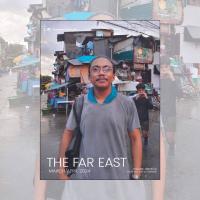
Temporary camps in Myanmar that have become permanent homes. Photos: Fr Patrick Raleigh SSC
Nba Bum Nu was only fourteen years old when the conflict started in the Kachin State of Myanmar. Now he is twenty-three years old. His village is located between the Burmese Army camp and the Kachin Independent Army camp. There were times when the war was not so serious but when the Burmese army began using helicopters to bomb the village they had to leave. He moved into the camp in 2017. Nba Bum Nu preferred to stay in the village. There is plenty of fish and even gold. He could do anything he wanted in the village. He has not got used to staying in a camp. The Government gave them only a small room and no land to plant or cultivate.
One of the recent arrivals to the camp is U Ra Naw who came in 2018. He observed that it is overcrowded and not good for raising a family. The pandemic was also making the situation even more challenging for many families in the camp including his wife who works in China and could not return to the country. His daughter shared that it feels like being in prison. She too would rather return to her village. Many of the children we spoke to shared their desire to return to their homes.
The resumed war in Kachin land has displaced hundreds of families. They were driven out of their villages. Nine years later, temporary camps have now become their permanent homes. Still, many are yearning to return to their home villages. They have nowhere else to call home but the camps. The ongoing conflict in the Kachin homeland is one of many conflicts happening in Myanmar.
Camps dot many parts of the country including the borders with Bangladesh, China and Thailand. According to the Internal Displacement Monitoring Centre, inter-communal and political conflict trigger large numbers of new displacements. The Burmese army since the country’s independence in 1948 has engaged in many violent conflicts with the ethnic groups.
A ceasefire agreement was signed in 2015 but several groups in the Kachin, Shan and Chin states are still in active conflict with the military and regularly trigger displacement. Rakhine state was the scene of mass displacement in 2012 and more recently in 2016 and 2017 when 800,000 members of the Rohingya ethnic group sought refuge in neighbouring Bangladesh.

Temporary camps in Myanmar that have become permanent homes. Photos: Fr Patrick Raleigh SSC
Armed conflict is not the only reason why people flee their villages. Khon Ja, a development worker and peacemaker working with the local churches and engaging communities to help the Internally Displaced Peoples (IDPs) commented that the Kachin state is host to many internal migrants - displaced by climate change and agricultural and development projects. Central Myanmar, for example, is called the dry zone. Naturally, it is dry but due to climate change, it is getting worse. People can no longer cultivate the land and if they try the crops are very small. Water resources also dry up.
In one town I visited an entire village was left empty when the families moved to other locations because of the loss of the water source.
People also come to Kachin State to find employment or try their luck at finding precious stones like jade, amber and even gold. Large jade and other mines are found all over the state. All of these are linked to climate change and the scarcity of resources.
Lately, large Chinese investment in the agricultural and power sector has displaced many families and individuals. Many internally displaced individuals lost their land to these agricultural investments which are often banana plantations.
Some of their land has been converted to industrial and special economic zones. The Myitsone Dam Project, for example, although temporarily halted, has displaced entire villages. Other lands are land-mined, making returning to the villages impossible. The land and the forest are an integral part of the Kachin culture. For them the land and the forest is life. Losing their land and forest is death to their culture.
Pope Francis in his address for the World Migrants Day of Migrants and Refugees 2020 said “The tragedy of internally displaced people is one of the challenges of our contemporary world. Situations of conflict and humanitarian emergencies, aggravated by climate change, are increasing the numbers of displaced persons and affecting people already living in a state of dire poverty. Many of the countries experiencing these situations lack adequate structures for meeting the needs of the displaced.” He reminded us that Jesus, with his parents, Joseph and Mary, was forced to flee and he wants to affirm that “displaced people offer us this opportunity to meet the Lord, even though our eyes find it hard to recognize him: his clothing in tatters, his feet dirty, his face disfigured, his body wounded, his tongue unable to speak our language.”
He invites us all to respond to this pastoral challenge by welcoming, protecting, promoting and integrating internally displaced peoples.
Columban Fr Kurt Zion Pala lives and works in Myanmar.
Listen to "Simply Paul"
Related links
- Read more from The Far East - April 2021

